During classical antiquity, Albania was home to several Illyrian tribes such as the Albanoi, Ardiaei, Bylliones, Dassaretii, Enchele, Labeatae, Taulantii, Parthini, Penestae, Amantes, and many others, but also Bryges and Epirote tribes, as well as several Greek colonies established on the Illyrian coast in cooperation with the local Illyrians, notably Epidamnos-Dyrrhachium and Apollonia.

Zog I was the leader of Albania from 1922 to 1939. At age 27, he first served as Albania's youngest Prime Minister ever (1922–1924), then as president (1925–1928), and finally as king (1928–1939).

In Albania, World War II began with its invasion by Italy in April 1939. Fascist Italy set up Albania as its protectorate or puppet state. The resistance was largely carried out by Communist groups against the Italian and then German occupation in Albania. At first independent, the Communist groups united in the beginning of 1942, which ultimately led to the successful liberation of the country in 1944.
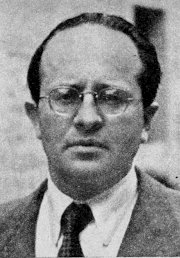
Fernando Mezzasoma, also referred to as Ferdinando, was an Italian fascist journalist and political figure. He was deputy national secretary of the National Fascist Party and Minister of Popular Culture of the Italian Social Republic.

The Albanian Fascist Militia (MFSH) (Albanian: Milicia Fashiste Shqiptare) was an Albanian fascist paramilitary group formed in 1939, following the Italian invasion of Albania. As a wing of the Italian Blackshirts (MVSN), the militia initially consisted of Italian colonists in Albania but later Albanian volunteers were also enlisted and made the majority of the group until it was disbanded in 1943. It was headquartered in Tirana.

Italian fascism, also known as classical fascism or simply fascism, is the original fascist ideology as developed in Italy by Giovanni Gentile and Benito Mussolini. The ideology is associated with a series of two political parties led by Benito Mussolini: the National Fascist Party (PNF), which ruled the Kingdom of Italy from 1922 until 1943, and the Republican Fascist Party (PFR) that ruled the Italian Social Republic from 1943 to 1945. Italian fascism is also associated with the post-war Italian Social Movement (MSI) and subsequent Italian neo-fascist movements.

Mehdi bey Frashëri was an Albanian intellectual and politician. He served as Prime Minister of Albania in the 1930s and as Chairman of the Provisional Administration Committee in the Albanian puppet government under Nazi Germany.
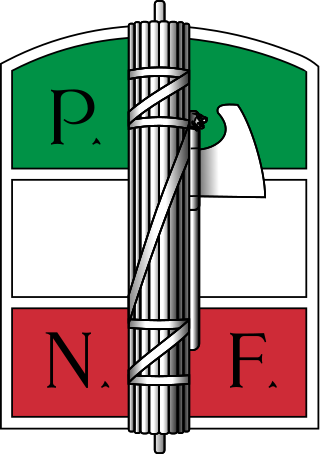
The National Fascist Party was a political party in Italy, created by Benito Mussolini as the political expression of Italian fascism and as a reorganisation of the previous Italian Fasces of Combat. The party ruled the Kingdom of Italy from 1922 when Fascists took power with the March on Rome until the fall of the Fascist regime in 1943, when Mussolini was deposed by the Grand Council of Fascism. It was succeeded, in the territories under the control of the Italian Social Republic, by the Republican Fascist Party, ultimately dissolved at the end of World War II.
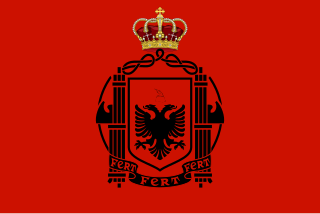
The Italian protectorate of Albania, also known as the Kingdom of Albania or Greater Albania, existed as a puppet state and protectorate of the Kingdom of Italy under Fascism. It was practically a union between Italy and Albania, officially led by Italy's King Victor Emmanuel III and its government: Albania was led by Italian governors, after being militarily occupied by Italy, from 1939 until 1943. During this time, Albania ceased to exist as an independent country and became an autonomous part of the Italian Empire. Officials intended to make Albania part of a Greater Italy by assimilating Albanians as Italians and colonizing Albania with Italian settlers from the Italian Peninsula to transform it gradually into an Italian land.

Ekrem Bey Libohova was an Albanian politician and Axis collaborator. He served as the Prime Minister of Albania on two occasions during the Italian occupation of Albania.

The Italian invasion of Albania was a brief military campaign which was launched by the Kingdom of Italy against the Albanian Kingdom in 1939. The conflict was a result of the imperialistic policies of the Italian prime minister and dictator Benito Mussolini. Albania was rapidly overrun, its ruler King Zog I went into exile in neighboring Greece, and the country was made a part of the Italian Empire as a protectorate in personal union with the Italian Crown.

The Italian colonial empire, also known as the Italian Empire between 1936 and 1941, was founded in Africa in the 19th century and it comprised the colonies, protectorates, concessions and dependencies of the Kingdom of Italy. In Africa, the colonial empire included the territories of present-day Libya, Eritrea, Somalia and Ethiopia ; outside Africa, Italy possessed the Dodecanese Islands, Albania and had some concessions in China, including in Tianjin.

The Italian colonists in Albania were Italians who, between the two World Wars, moved to Albania to colonize the Balkan country for the Kingdom of Italy.

Xhafer Deva was a fascist Kosovo Albanian politician during World War II. A notable local politician in Kosovo and in Axis-occupied Albania, he took charge of German-occupied Mitrovica and worked with the Germans to establish a pro-German Albanian government in Kosovo. Following the capitulation of Italy from the war, he helped form a provisional government under German occupation and set up the Second League of Prizren alongside other Albanian nationalists.

Tefik Selim Mborja was an Albanian politician and lawyer. He served as the general secretary of the Albanian Fascist Party during the Second World War.

Albanian Lictor Youth was a youth organization which served as the youth wing of the Albanian Fascist Party. The Albanian Lictor Youth was one of the associated organizations of the Albanian Fascist Party, as stipulated in its statute, which was formulated in a decree of the Italian vicegerent issued on 2 June 1939.
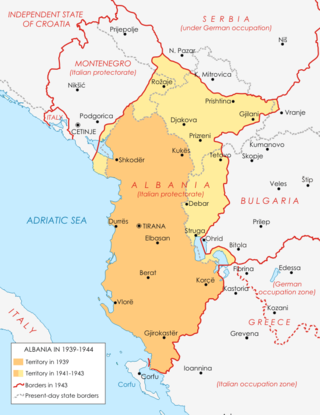
The Holocaust in Albania consisted of crimes committed against Jews in Albania while Albania was under Italian and German occupation during World War II. Throughout the war, nearly 2,000 Jews sought refuge in Albania-proper. Most of these Jewish refugees were treated well by the local population, despite the fact that Albania-proper was occupied first by Fascist Italy, and then by Nazi Germany. Albanians often sheltered Jewish refugees in mountain villages and transported them to Adriatic ports from where they fled to Italy. Other Jews joined resistance movements throughout the country.
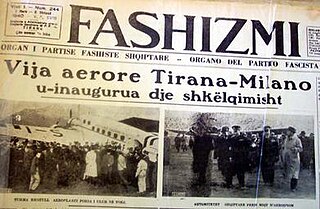
Fashizmi ('Fascism') was a daily Albanian-Italian bilingual newspaper published from Tirana, Albanian Kingdom 1939-1940. It functioned as the official organ of the Albanian Fascist Party. Fejzi Alizoti was the editor of Fashizmi. Vangjel Koça served as the managing director of the newspaper.
Liktori ('Lictor') was a twice-weekly Albanian-Italian bilingual newspaper published from Korçë during the Italian occupation of Albania. The newspaper was founded on July 9, 1939, replacing Korça fashiste of Zhan Gorguzi. Initially Dr. Guljelm Deba served as the director of Liktori. On September 14, 1940 Lluka Bibi took over as director.
The Treaties of Tirana were signed in Tirana between Albania and Italy in the 1920s, bringing Albania into the Italian sphere of influence and gradually turning the Albania state into a de facto protectorate of Italy.

















